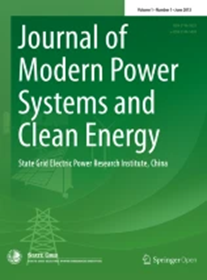Distributed Hierarchical Transactive Energy Management to Exploit Flexibilities in Transmission Systems
IF 6.1
1区 工程技术
Q1 ENGINEERING, ELECTRICAL & ELECTRONIC
Journal of Modern Power Systems and Clean Energy
Pub Date : 2024-11-22
DOI:10.35833/MPCE.2024.000859
引用次数: 0
Abstract
Advanced management algorithms are required in modern power systems to sustain energy supply with the highest availability and lowest cost. These algorithms need to be capable of not only maintaining scalability, tractability, and privacy, but also enabling the utilization of grid-edge aggregated flex-ibilities in transmission systems. This paper proposes a distributed hierarchical transactive energy management (TEM) scheme to manage peak load and line congestion problems using connected and aggregated flexibilities. In the scheme, resource owners can privately solve their respective preference problems and send their scheduled power to the corresponding node operator (NO). Afterward, NOs solve a coordination problem to harmonize the actions of resource owners at the same node. Meanwhile, the independent system operator (ISO) updates control signals to steer the scheduled power to a feasible and optimal point. To accomplish all these, a hybrid decomposition approach is further proposed based on consensus+exchange alternating direction method of multipliers (CE-ADMM) and dual decomposition (DD) (CE-ADMM + DD). Besides, a dynamically constrained cutting plane (DC-CP) update algorithm is evolved to control the feasibility condition and minimize sensitivity to initialization. The proposed hybrid decomposition approach is verified and its performance is compared with other reported approaches. Application to various networks verifies its scalability, enhanced accuracy, and convergence speed.利用输电系统灵活性的分布式分层交互能量管理
现代电力系统需要先进的管理算法,以保证最高的可用性和最低的成本。这些算法不仅需要能够保持可伸缩性、可跟踪性和隐私性,而且还需要能够在传输系统中利用电网边缘聚合的灵活性。本文提出了一种分布式分层交互能源管理(TEM)方案,利用连接和聚合的灵活性来管理高峰负荷和线路拥塞问题。在该方案中,资源所有者可以私下解决各自的偏好问题,并将其计划功率发送给相应的节点运营商(NO)。然后,NOs解决了一个协调问题,以协调同一节点上资源所有者的行动。同时,独立系统操作员(ISO)更新控制信号,将计划功率引导到可行的最优点。为此,在共识+交换交替方向乘数法(CE-ADMM)和对偶分解(CE-ADMM + DD)的基础上,进一步提出了一种混合分解方法。此外,提出了一种动态约束切割平面(DC-CP)更新算法,以控制可行性条件和最小化初始化灵敏度。对所提出的混合分解方法进行了验证,并与已有的混合分解方法进行了性能比较。在各种网络中的应用验证了该方法的可扩展性、精度和收敛速度的提高。
本文章由计算机程序翻译,如有差异,请以英文原文为准。
求助全文
约1分钟内获得全文
求助全文
来源期刊

Journal of Modern Power Systems and Clean Energy
ENGINEERING, ELECTRICAL & ELECTRONIC-
CiteScore
12.30
自引率
14.30%
发文量
97
审稿时长
13 weeks
期刊介绍:
Journal of Modern Power Systems and Clean Energy (MPCE), commencing from June, 2013, is a newly established, peer-reviewed and quarterly published journal in English. It is the first international power engineering journal originated in mainland China. MPCE publishes original papers, short letters and review articles in the field of modern power systems with focus on smart grid technology and renewable energy integration, etc.
 求助内容:
求助内容: 应助结果提醒方式:
应助结果提醒方式:


